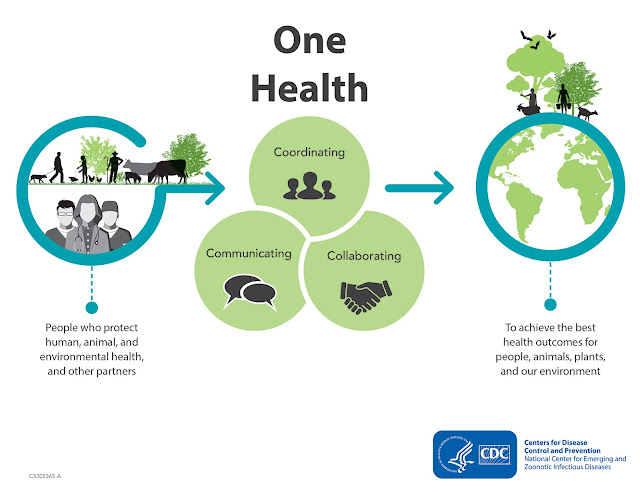A One Health Primer
 |
| Figure courtesy of the Centers for Disease Control and Prevention |
This week's post is going to stray just a bit from the standard in that I won't be discussing a specific disease. Rather, I am writing this week on a collaborative approach known by people in the field as One Health. The American Veterinary Medical Association (AVMA) defines this concept as "...the collaborative effort of multiple disciplines-working locally, nationally, and globally-to attain optimal health for people, animals, and our environment." In my opinion, this is a rather vague definition (this is from a formal report by the AVMA discussing one health) and I much prefer the Centers for Disease Control and Prevention's definition which is much more narrowed down. The CDC defines One Health as a concept "...that recognizes that the health of people is connected to the health of animals and the environment. It is a collaborative, multisectoral, and transdisciplinary approach with the goal of achieving optimal health outcomes recognizing the interconnection between people, animals, plants, and their shared environment."
When applied correctly, One Health works when many different people with a many ranges of experiences and professions come together to dedicate themselves and their research to achieving better public health outcomes. The World Health Organization (WHO) states that "the areas of work in which a One Health approach is particularly relevant include food safety, the control of zoonoses, and combatting antibiotic resistance." The biggest push for One Health initially came from the AVMA and other wildlife and animal professionals in order to fight the coming storm of zoonotic diseases. To check out the timeline of events that took place in order for One Health to be where it is now, please click this link.
My primary research source for this week's blog post is the final report posted by the AVMA detailing what they as an organization will do to promote and launch One Health as a primary idea. If anyone is interested in reading this report (and I suggest taking a look at it), it can be found here. I will begin by quoting the AVMA's vision statement for One Health, "To promote and improve the health of humans, animals, and our environment, individually and collectively, by encouraging and ensuring the acceptance and adoption of One Health and its associated activities."
 |
| Figure courtesy of the Centers for Disease Control and Prevention |
So why is all of this important? The AVMA report states that of the 1,461 diseases currently recognized by humans, approximately 60% of them are due to multi-host pathogens, meaning that these diseases can be passed between multiple species as the host. On top of all that, over the last three decades, approximately 75% of new emerging human infectious diseases are defined as being zoonotic (spread between humans and animals). So humans and animals are two of the three factors of One Health. The environment is the third part of our One Health dynamic and it too plays a very key role in animal and human health. This is because the destruction and/or deterioration of the environment can allow for the expansion of infectious diseases into human and animal populations.
Smolinski et al. (2003) have detailed a group of factors that have come together to create what they call a "perfect microbial storm." These factors are the "...adaptation of microbes, global travel and transportation, host susceptibility, intent to do harm, climate change, economic development and land use, human demographics and behavior, a breakdown of both public and animal health infrastructures, poverty, and social inequality." With these factors playing a role in disease transmission, there are many threats to both humans and animals. These threats include the spread of HIV-AIDS, SARS, West Nile Virus, and monkeypox throughout Africa. The emerging prion diseases like Bovine Spongiform Encephalopathy in cattle, Creutzfeldt-Jakob Disease in humans, and Chronic Wasting Disease in deer. Finally, the death each year of roughly around 1.5 million people from diarrheal diseases. These are just a few examples of disease introduction and spread over the last 10-20 years and they are golden reasons for why this One Health approach is important.
The AVMA final report details multiple benefits for the implementation of One Health into research, no matter what your health profession is. The biggest benefits in my opinion are the following:
1) To improve animal and human health globally through collaboration among all the health sciences, especially between the veterinary and human medical professions to address critical needs.
2) Meeting new global challenges head-on through collaboration among multiple professions--veterinary medicine, human medicine, environmental, wildlife, and public health.
3) Adding to our scientific knowledge to create innovative programs to improve health.
Other Items of Interest:
* If you are interested in seeing One Health being used in life, click here.
* The idea of "One Health" has been around since Hippocrates. If you are interested in reading his work titled "One Airs, Waters, and Places" click here.
* If you are interested in seeing how the American Medical Association has responded to One Health and changed their own constitution, click here.
Literature Cited:
American
Veterinary Medical Association. (2019). One Health-What is One Health? Retrieved
from American Veterinary Medical Association :
https://www.avma.org/KB/Resources/Reference/Pages/One-Health94.aspx
American
Veterinary Medical Association-One Health Initiative Task Force. (2008, July).
One Health: A New Professional Imperative. Retrieved from American
Veterinary Medical Association:
https://www.avma.org/KB/Resources/Reports/Documents/onehealth_final.pdf
Centers for
Disease Control and Prevention. (2019, March). One Health. Retrieved
from Centers for Disease Control and Prevention:
https://www.cdc.gov/onehealth/index.html
Nolen, R. S.
(2007, July). AMA adopts one-health policy-Physicians' association supports
ties with AVMA. Retrieved from American Veterinary Medical Association:
https://www.avma.org/News/JAVMANews/Pages/070801b.asp
Smolinski MS, Hamburg MA, Lederberg
J, eds. Microbial threats to health, emergence, detection, and response.
Washington, DC: Institute of Medicine, National Academies Press, 2003)
World Health
Organization. (2017, September). One Health. Retrieved from World
Health Organization: https://www.who.int/features/qa/one-health/en/


Comments
Post a Comment